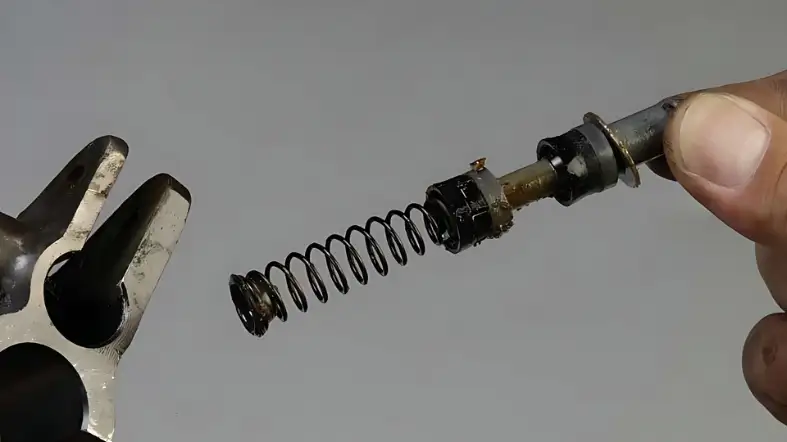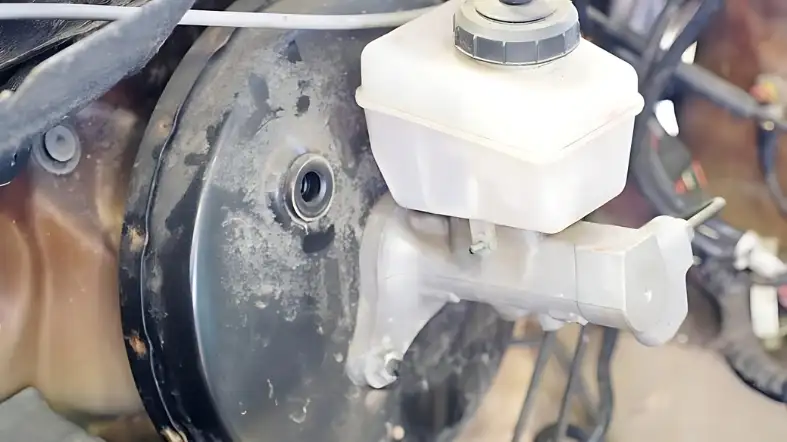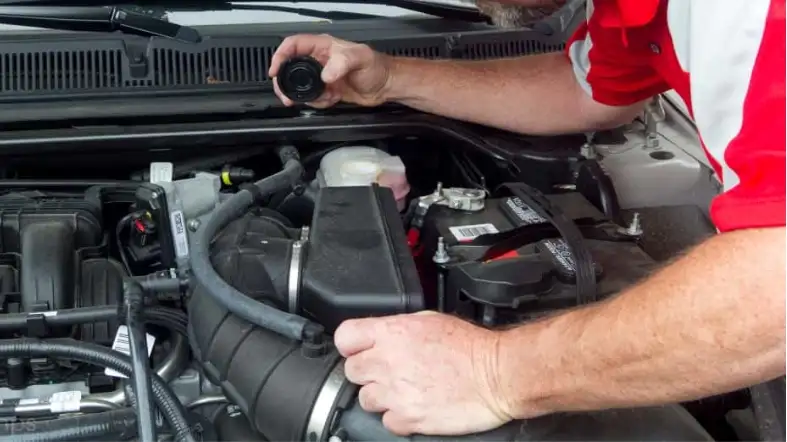The master cylinder is a critical component of this system, converting the force from the brake pedal into hydraulic pressure that actuates the brakes.
Over time, dirt, debris, and other contaminants can accumulate inside the master cylinder, leading to decreased brake performance.
This blog post will guide you through cleaning a master cylinder, helping you keep your braking system in top condition.

How To Clean A Master Cylinder?
Cleaning a master cylinder is an important maintenance task that can help to ensure your vehicle’s brake system operates properly. Here are the steps to clean a master cylinder:
Disconnect the master cylinder from the brake lines:
Before you begin cleaning the master cylinder, you’ll need to disconnect it from the brake lines. This will prevent brake fluid from leaking out of the system during cleaning.
Remove the reservoir and any loose debris:
Once the master cylinder is disconnected from the brake lines, it’s time to spruce up.
Remove any loose debris with a clean cloth or paper towel, and give that reservoir a good wipe down.
To get in there and ensure your brakes are running at their peak performance, dive into cleaning the inside of the master cylinder – it’ll be worth it.
Not only will you feel more confident when you hit those curves on your next road trip, but you also trust that all systems are going for safe braking.
Clean the inside of the master cylinder:
Drench it in a brake cleaner solution for a few minutes and let it do its thing. Grab a trusty brush and scrub away any dirt or debris on the cylinder walls – no stone unturned.
Rinse the master cylinder:
Once you’ve scrubbed the inside of the master cylinder, rinse it thoroughly with clean water. This will help to remove any remaining dirt or debris.
Dry the master cylinder:
After rinsing the master cylinder, use a clean, lint-free cloth to dry it thoroughly. Be sure to remove any excess water from the cylinder before reattaching it to the brake lines.
Reconnect the master cylinder:
Finally, reattach the master cylinder to the brake lines and refill the reservoir with fresh brake fluid.
Check the brake system for leaks and make sure the brakes are functioning properly before driving your vehicle.
How do you flush a master cylinder?

Gather the necessary tools and materials:
Gather the right tools and materials before starting to flush your master cylinder.
You’ll need a wrench or pliers, a clear plastic hose, a container for catching brake fluid, and fresh brake fluid recommended by your vehicle manufacturer.
It’s important that you use the correct type of brake fluid specified in the owner’s manual – no substitutions!
Now you’re ready to begin flushing out that master cylinder like a pro.
Locate the master cylinder:
The master cylinder is usually located near the brake booster on the driver’s side of the engine compartment.
It’s a small, round container with a cap on top. The cap may be labeled with the type of brake fluid to use.
Remove the old brake fluid:
Use the wrench or pliers to loosen the cap on the master cylinder and remove it.
Use the clear plastic hose to siphon out the old brake fluid from the reservoir and into the container.
Be sure to dispose of the old brake fluid properly, as it is hazardous waste.
Fill the master cylinder with fresh brake fluid:
Once the old brake fluid has been removed, fill the master cylinder with fresh brake fluid up to the recommended level.
Do not overfill the reservoir, as this can cause leaks and other problems.
Bleed the brake system:
You’ll need to bleed the brakes to ensure that all of the old brake fluid has been flushed out of the system.
This involves opening the bleeder valves on each brake caliper or wheel cylinder and draining the old brake fluid.
You can do this by attaching the clear plastic hose to the bleeder valve and opening it with a wrench or pliers.
Have a friend pump the brake pedal to push out the old brake fluid until the new fluid comes out clear.
Repeat as necessary:
You may need to repeat the flushing process several times until the brake fluid from the bleeder valves is completely clear and free of air bubbles.
Replace the master cylinder cap:
Once you have finished flushing the master cylinder and bleeding the brake system, replace the cap on the master cylinder and tighten it securely.
What Are The Symptoms Of A Dirty Master Cylinder?

Spongy or soft brake pedal:
If you notice that the brake pedal feels spongy or soft, it could be a sign that the master cylinder is dirty or contaminated.
This is because the contaminants in the brake fluid can cause the master cylinder seals to deteriorate or become damaged, leading to a loss of pressure in the brake system.
Brake fluid leaks:
A dirty master cylinder can also cause brake fluid leaks. Contaminants in the brake fluid can damage the seals in the master cylinder, causing fluid to leak out of the reservoir or from around the cylinder itself.
Reduced braking performance:
Another symptom of a dirty master cylinder is reduced braking performance.
If the master cylinder is not functioning properly, it can cause the brake system to lose pressure, which can lead to longer stopping distances or difficulty stopping the vehicle altogether.
Brake pedal sticking or not returning:
Contaminants in the brake fluid can cause the brake pedal to stick or not return to its normal position.
This can be dangerous because it can prevent you from being able to accelerate or brake as needed.
Contaminated brake fluid:
If the brake fluid in the master cylinder looks dirty or has a milky appearance, it’s a clear indication that the master cylinder may be dirty or contaminated.
This is because contaminants in the brake fluid can cause it to break down or become contaminated, leading to problems in the brake system.
How Do I Test If My Master Cylinder Is Bad?

Here are some ways to check if your master cylinder is working correctly:
Brake Pedal Test:
While the car is parked and the engine is running, press down firmly on the brake pedal until it stops.
Hold the pedal down and observe whether it sinks or not. If it does, it could indicate a failing master cylinder.
Firm Brake Pedal Test:
With the brake system bled, pump the brakes a few times and hold. The brake pedal should be firm.
If the pedal feels spongy, this could indicate air remaining in the lines or a mechanical problem, such as a sticking brake caliper.
Brake Fluid Level Check:
Look inside the master cylinder. The brake fluid should be up to the “Full” line on the side of the cylinder or within 1/2 inch of the top of each chamber.
If it isn’t, add the proper brake fluid for your vehicle until the level meets the line.
Brake fluid leaks of any kind will put you and others in danger, so any master cylinder fault is the reason for replacement.
Abnormal Brake Pedal Behavior:
If your brake pedal suddenly starts to feel spongy or mushy, or if you have to exert extra pressure on the brake pedal, it could mean that your car’s master cylinder needs replacing.
Internal Leak Check:
Check if any fluid leaks are noticeable; they might be along the body of the reservoir or near the opening of the cylinder.
If that is the case, then you might need to replace the bad master cylinder.
Frequently Asked Question
q. What Tools Will I Need To Clean My Master Cylinder?
A: You’ll need a clean cloth, a small brush, a container of brake fluid, and a can of brake cleaner.
You may also need a set of pliers to remove the cap from the master cylinder.
Q. How Often Should I Clean My Master Cylinder?
A: It’s a good idea to clean your master cylinder whenever you perform any maintenance on your braking system or if you notice any signs of brake fluid leaks or contamination.
Q. What Should I Look For When Inspecting My Master Cylinder?
A: When inspecting your master cylinder, look for any signs of leaks, such as fluid on the outside of the cylinder or on the ground near the vehicle.
You should also check the color and clarity of the brake fluid and the level in the master cylinder reservoir.
Q. Can I Use Any Type Of Cleaner To Clean My Master Cylinder?
A: No, you should only use brake cleaner to clean your master cylinder.
Other cleaners may damage the rubber seals and other components of the braking system.
Q. How Do I Clean The Internal Components Of My Master Cylinder?
You can then clean the individual components with brake cleaner and a brush, being careful not to damage any of the rubber seals.
A: Can Brake Fluid Be Reused After Cleaning My Master Cylinder?
No, it’s not safe to reuse brake fluid after cleaning your master cylinder.
Brake fluid is hygroscopic, which means it absorbs moisture over time.
Conclusion:
Cleaning your master cylinder is an essential maintenance task that can help restore your vehicle’s braking performance.
Inspect all brake components for wear or damage and replace parts as needed.
